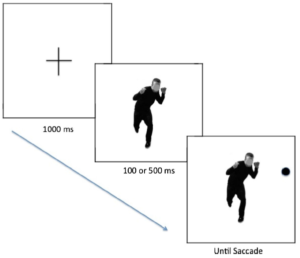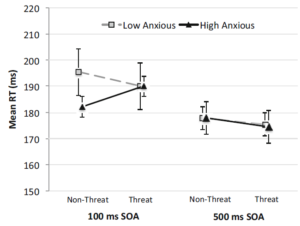Traces of our evolutionary history linger within us and can be detected in many circumstances. For example, some time ago we noted on this website that processing information with respect to its survival value—that is, whether a knife or a sofa might be of greater use when you are stranded on an island—provides you with a memorial advantage. Apparently our memories are retaining things best when our survival is at stake.
Another cognitive function that aids survival is threat detection. An organism’s survival is aided by the rapid detection of threats. People are not that different from cats. Although we may be less likely to jump at the sight of a cucumber, numerous studies using visual search tasks have revealed that people orient their attention automatically to threatening stimuli such as angry faces, snakes, or spiders. (If you live in a country that has more potent venomous animals than any other on Earth, then you also learn to jump at the sight of oddly shaped sticks and curled-up garden hoses. Gardening in England is so much more relaxing.)
In addition to capturing attention, threatening stimuli also cause our attention to dwell on the attended threat. Once you’ve come to believe that the stick among the roses is a dugite, smelling those roses takes the backseat for quite a while. This attentional dwelling is even reflected in our eye movements: Once you look at an angry face, your eyes seem to be “locked” onto that stimulus for longer than if you looked at a less threatening stimulus.
A recent article in the Psychonomic Bulletin & Review examined whether such special attentional processing also extended to threatening bodily postures. Is this person holding a knife in their raised hand? Are they about to jump at me?
Past research has shown that faces are special stimuli that receive preferential visual processing and that activate dedicated brain regions that are not involved in the processing of other stimuli. It is therefore not immediately certain that the attentional effects observed with angry faces would transfer to bodily postures. But on the other hand, body postures present a more salient threat than faces because they represent an actual immediate physical threat, whereas faces just warn of one. So maybe postures should also attract our attention?
Researchers Azarian, Esser and Peterson presented participants with photographs of postures such as those shown in the figure below:

Can you tell the emotions that are expressed by the various postures? Which one did you look at the longest? The neutral guy on the very right or the angry fellow next to him? And surely you can guess the remaining two emotions displayed by the two characters on the left.
Azarian and colleagues recruited participants that were either low or high in trait anxiety. Trait anxiety is defined as “a relatively enduring disposition to feel stress, worry, and discomfort.” In extreme cases, a person high in trait anxiety may feel anxious in an array of normal situations such as going to the movies or attending a lecture. Given that the question of interest was how people would respond to threatening stimuli, the inclusion of this individual-differences variable provided valuable additional information.
Participants’ task was simplicity itself. Presentation of the posture stimulus on the screen was followed a brief time later by the appearance of a circle (the “target”) to the right or to the left of the posture. All participants had to do was to look at that target. Participants’ eye movements were recorded and the measure of interest was how long it took people to move their eyes. The figure below summarizes a sample trial:

The figure also clarifies that the time between appearance of the posture stimulus and the target (known as stimulus-onset asynchrony or SOA) was manipulated across trials. The target appeared almost instantly (100 ms; 1/10th of a second) or after 500ms (half a second).
The results are shown in the figure below, which displays the time taken to move eyes to the target after it appeared as a function of the three main experimental variables. Note that for the figure, the stimuli were collapsed into the angry (threat-related) postures versus the others (which did not differ):

The interpretation of the results is straightforward: Once attended, threatening postures automatically affect attentional disengagement at short SOAs, but only in people with high levels of trait anxiety. High-trait-anxiety participants took longer to shift their eyes towards the target when the posture expressed anger relative to happy or neutral postures. If we are anxious, our eyes lock onto something that appears threatening, and we have a hard time looking away. (When sufficient time has elapsed, this is no longer an issue; we seem to have done all that’s needed with the threatening stimulus within the first half second).
Why would people want to dwell longer on threatening stimuli, especially if they are anxious already? Would it not make more sense to avert one’s glance as quickly as possible?
There are two competing hypotheses to explain why people dwell on fear-inducing stimuli. The first hypothesis holds that dwelling allots more time for processing of the threat so that an appropriate defense strategy can be developed. One implication of this hypothesis is that regardless of our level of trait anxiety, we should all be focusing on threat stimuli when they are present to develop our defense strategy. The contrasting hypothesis is that prolonged dwelling is not adaptive. The failure to quickly disengage attention keeps us focused on the threat, thereby enhancing our anxiety, and over time leading to prolonged worry.
Two aspects of the data of Azarian and colleagues favor the second hypothesis: First, the attentional dwelling on fear-inducing stimuli was only observed for high-anxious individuals. This runs counter to the idea that fear-inducing stimuli are processed to prepare an appropriate response—because that presumably would also be done by low-anxious individuals. Second, the fact that low-anxious individuals looked away from the fear-inducing stimulus very quickly is compatible with the idea that it is their ability to disengage that keeps their anxiety low. Perhaps we don’t look at threatening stimuli because we are anxious, but we are anxious because whenever there is a threatening stimulus, we cannot disengage from processing it.
Watch that stick, it seems to move while I stare at it. And beware the garden hose, it’s merely asleep but waiting to pounce…. OMG, watch the cucumber!
Reference for the article discussed in this post:
Azarian, B., Esser, E. G. & Peterson, M. S. (2015). Evidence from the eyes: Threatening postures hold attention. Psychonomic Bulletin & Review. DOI: 10.3758/s13423-015-0942-0.

2 Comments